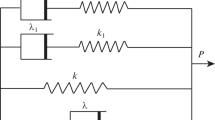Conclusions
The simplest mechanical block model of a medium, whose behavior is determined by Hooke's generalized law of elasticity for small deformations, and by classical laws of plasticity for more significant deformations, is constructed.
It is shown that conversion from a mechanical block model of a medium, which has finite block dimensions, to an idealized model consisting of blocks of zero dimensions (a plane with a thickness equal to zero), occurs with retention of the directions of simple shears and simple elongations, or the directions of the slip planes (a slip plane is a plane, along the normal to which simple elongation occurs; two simple shears occur in two mutually orthogonal directions falling in the plane).
Symmetry of simple shears does not follow from the symmetry of the strain tensor. The components of the vector {ie306-1} are referenced from states of pure shear.
Dynamic manifestations of the model under consideration for a medium will be discussed in the next part of the study.
Similar content being viewed by others
References
A. Nadai, Plasticity and Failure of Rigid Bodies [Russian translation], Izdatel'stvo Inostrannoi Literatury, Moscow (1954).
T. Thomas, Plastic Flow and Failure in Rigid Bodies [Russian translation]. Mir, Moscow (1964).
J. R. Rice. “The localization of plastic deformation,” in: Theoretical and Applied Mechanics. Proceedings of the Fourteenth IUTAM Congress, Amsterdam, North Holland (1976), pp. 207–220.
J. W. Rudnicki and J. R. Rice, “Condition for the localization of deformation in pressure-sensitive dilatant materials,” J. Mech. Phys. Solids,23, 371–394 (1975).
I. V. Nikitin and E. I. Ryzhak, “Failure of rock with internal pressure and dilatancy,” {jtDokl. Akad. Nauk SSSR}, {vn230}, {snNo. 5} ({dy1976}).
I. A. Garagash, “Stability and failure of natural masses with applications to the mechanics of earthquake preparation,” Author's Dissertation for Doctor of Physical and Mathematical Sciences, Institut Fikiki Zemli, Akademiya Nauk SSSR, Moscow (1985).
M. V. Kurlenya and A. M. Kovrizhnykh, “Early prediction of the seat of failure in rocks,” Fiz.-Tekh. Probl. Razrab. Polezn. Iskop., No. 6 (1995).
A. I. Chanyshev, “On allowable forms of plasticity relationships from the standpoint of the theorem of uniqueness,” {jtPrikl. Mekh. Tekh. Fiz.}, {vn38}, {snNo. 6} ({dy1997}).
A. F. Revuzhenko, “Rock—a medium with internal energy sources and fluxes. Reports 1 and 2,” Fiz.-Tekh. Probl. Razrab. Polezn. Iskop, No. 4, 14–21 (1990); No. 5, 9–15 (1990).
N. I. Muskhelishvili, Some Basic Problems of the Mathematical Theory of Elasticity [in Russian], Izdatel'stvo Akademii Nauk SSSR, Moscow (1949).
S. P. Strelkov, Mechanics [in Russian], Nauka, Moscow (1975).
G. Korn and T. Korn, Mathematics Handbook for Scientific Workers and Engineers [in Russian], Nauka, Moscow (1986).
Additional information
Mining Institute. Siberian Branch of the Russian Academy of Sciences, Novosibirsk. Translated from Fiziko-Tekhnicheskie Problemy Razrabotki Poleznykh Iskopaemykh, No. 4, pp. 26–35, July–August, 1998.
Rights and permissions
About this article
Cite this article
Chanyshev, A.I. Phenomenological mechanical block model of an element of a deformable medium. Part 1: Definition and basic properties. J Min Sci 34, 300–307 (1998). https://doi.org/10.1007/BF02803689
Received:
Issue Date:
DOI: https://doi.org/10.1007/BF02803689




